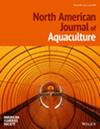Comparing the incidence of spontaneous autopolyploidy in wild and hatchery Lake Sturgeon
IF 1.3
4区 农林科学
Q3 FISHERIES
引用次数: 0
Abstract
Abstract Living species of Acipenseriformes, sturgeon and paddlefish, are characteristically polyploid, having more than two complete sets of chromosomes (>2n). They undergo spontaneous autopolyploidy, an unintentional one and a half times increase in genome size, more frequently than any other order of fish. For Lake Sturgeon Acipenser fulvescens which are evolutionary octoploids (8n), spontaneous autopolyploidy results in fertile dodecaploid (12n) progeny. When 12n individuals’ reproduce with octoploids, it is possible that resulting decaploid (10n) offspring will have poor physiological performance and survivorship. Spontaneous autopolyploidy in the wild is very low; however, incidence in fish hatcheries is greater, as seen in other 8n sturgeon species. We investigated this disparity in Lake Sturgeon, predicting to find more dodecaploid individuals’ in hatchery populations than in the wild. Ploidy was determined using red blood cells from individuals’ in three hatchery and two wild populations of Lake Sturgeon in Manitoba, Canada ( n = 1004). Red blood cell volume was evaluated with a Z2 Coulter Counter and used to determine ploidy, based on the average of triplicate measures of the erythrocyte modal nuclei volume (fL). A subsample from each environment type was further examined using blood smear analysis ( n = 130) and flow cytometry ( n = 27). One 12n hatchery individual was found, along with significant differences in erythrocyte morphometry between the five populations. Fluctuations in modal nuclei volume were also observed over 169 days of repeated measurement within a single hatchery population. The well‐developed relationship between erythrocyte size and fishes external and physiological environment may explain the variance both between and within populations. These results demonstrate the need for ploidy monitoring in artificial hatcheries, as releasing even a single 12n fish could produce thousands of 10n offspring, that if recruited, would have a detrimental effect on the populations fitness.野生和孵化湖鲟自发自多倍体发生率的比较
摘要:鲟鱼和白鲟等现存的亚纲鱼类具有多倍体的特征,具有两套以上的完整染色体(>2n)。它们经历了自发的自多倍体,在无意中增加了1.5倍的基因组大小,比任何其他鱼类都要频繁。对于进化为八倍体(8n)的富尔维斯湖鲟,自发的自多倍体产生可育的十二倍体(12n)后代。当12n个个体用八倍体繁殖时,产生的十倍体(10n个)后代的生理性能和存活率可能较差。自然的自体多倍体在野外是很低的;然而,在鱼类孵化场的发病率更高,在其他8n种鲟鱼中也可以看到。我们在斯特金湖调查了这种差异,预测在孵化场种群中发现的十二倍体个体比在野外发现的要多。利用加拿大马尼托巴省3个孵化场和2个斯特金湖野生种群的个体红细胞(n = 1004)测定了倍性。用Z2 Coulter计数器评估红细胞体积,并根据红细胞模态核体积(fL)的三次测量的平均值来确定倍性。采用血液涂片分析(n = 130)和流式细胞术(n = 27)进一步检查每种环境类型的亚样本。在5个种群中发现了1个12n的孵化场个体,并且红细胞形态在5个种群之间存在显著差异。在一个孵化场种群中,在169天的重复测量中也观察到模态核体积的波动。红细胞大小与鱼类外部和生理环境之间的良好关系可以解释种群间和种群内的差异。这些结果表明,人工孵化场需要进行倍性监测,因为即使释放一条12n的鱼也可能产生数千条10n的后代,如果招募的话,这将对种群健康产生不利影响。
本文章由计算机程序翻译,如有差异,请以英文原文为准。
求助全文
约1分钟内获得全文
求助全文
来源期刊
CiteScore
2.50
自引率
0.00%
发文量
46
审稿时长
18-36 weeks
期刊介绍:
The North American Journal of Aquaculture publishes papers on new research and practical experience in all areas of intensive and extensive fish culture. Topics include broodstock selection and spawning, nutrition and feeding, health and water quality, facilities and production technology, and the management of ponds, pens, and raceways.
The journal will consider papers dealing with ways to improve the husbandry of any aquatic species—marine or freshwater, vertebrate or invertebrate—raised for commercial, scientific, recreational, enhancement, or restoration purposes that may be of interest to practitioners in North America. Its scope includes both basic and applied science, but applied scientific endeavors—including practical experiences, descriptive studies, and other nontraditional, but pertinent works—are emphasized.

 求助内容:
求助内容: 应助结果提醒方式:
应助结果提醒方式:


